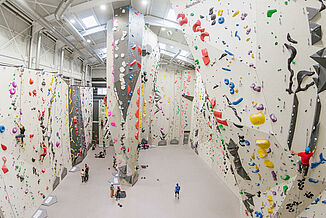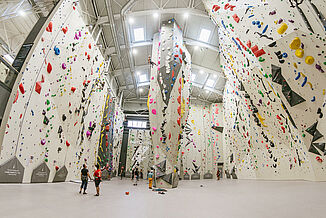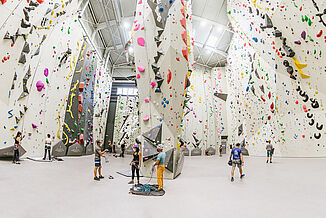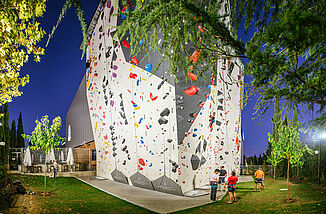Sputnik Climbing Hall Madrid, Spain
Climbing Hall "Las Rozas" in Madrid
The first Olympic champion in sport climbing does not come from the Czech Republic, Austria or the USA, but from Spain. Alberto Ginés López - 18 years old when he mounted the top step of the medal rostrum at the Summer Games in Tokyo 2020 - is a shooting star on the climbing scene. At the end of 2021 in the Spanish capital of Madrid, he was the sponsor for the opening of the Sputnik climbing hall "Las Rozas", in which REGUPOL floors were laid both inside and out.
Project overview
- 570 m² REGUPOL climb 77 stone grey - indoor area
- 60 m² REGUPOL climb fun light grey - outdoor area
Among climbing enthusiasts, Spain is known primarily for its outdoor climbing areas. Some of the highest mountains in Europe can be found on the Iberian Peninsula. Climbing fans from all over the world flock to Margalef, Siurana or the El Chorro rock massif all year round. Perhaps this explains why there are relatively few climbing halls in Spain - currently around 180. By way of comparison: in Germany, which is about 40% smaller in terms of area, the last survey in 2018 counted over 500 climbing halls.
Alberto Ginés López has high hopes for the new hall in Madrid. On numerous occasions, the Olympic champion has already publicly criticised the fact that training conditions for climbers in Spain are not particularly good and that he would like to see more support from the government and the federations. In his sport, he himself is uncompromising. At the age of 14, he moved from his birthplace of Cáceres to Barcelona, some 900 kilometres away, because training conditions there were better. The fact that a hall of this size and with this standard of equipment has now opened in the Spanish capital, which is much closer to his home, makes the 19-year-old very happy - as he has mentioned in various interviews.
160 routes of up to twenty metres, 48 of them outdoors, plus a speed wall, one of only two in the whole of Spain. And, incidentally, it was the speed event which was decisive for Alberto Ginés López's gold medal. The Sputnik company invested four million euros in the construction of what is now the largest climbing hall in the country.
And it’s not only the vertical equipment which is state-of-the-art. Horizontally too, in terms of fall protection on the ground, Sputnik wanted nothing but the best for "Las Rozas". To prepare for the construction project, Guillermo Burba, Manager of Operations at Sputnik, visited countless climbing halls across Europe. "We wanted to find out how others dealt with the many challenges that can arise in such a project - we were especially interested in the floors in front of the main climbing walls." Here demands are particularly rigorous: in "Las Rozas" the main wall is twenty metres high. Accordingly, safety requirements for the flooring are of overriding importance. But practical considerations must be taken equally seriously - is the floor easy to clean or can it be driven over with a cherry picker, for example. The latter feature makes the work of the route builders much easier, as in "Las Rozas", 25 new routes need to be bolted into place every week. If the floor does suffer any damage, due to tools being dropped, for example, the place in question can be repaired in a few easy steps using a repair kit that is separately supplied.
One thing Guillermo Burba discovered on his trip above all else: many halls, especially in Germany have REGUPOL floors. "To be honest, we were quite surprised to find such a uniform picture," says the Manager of Operations. He and his team quickly made enquiries: "Besides the convincing safety aspects, we were immediately very impressed by the number of possible variations."
In addition to choosing from 32 different colours for the floor covering, climbing hall operators can have logos, lettering and markings applied to the floor.
"In Madrid, we installed about 570 square metres of our REGUPOL climb 77 in stone grey," recalls Kai Mayer-Ullmann, Sales Associate in the Sports Division. "In the outdoor area, we also added around 60 square metres of REGUPOL climb fun in light grey." Both floors consist of several layers. The indoor floor has a 75-millimetre-thick elastic layer made of various composite foams and an approximately two-millimetre-thick polyurethane wear layer. Both the indoor and outdoor surfaces are seamless, which makes cleaning much easier. Due to the high force reduction and effective fall protection properties, the floor reduces the risk of injury after a fall and also ensures that the belayer on the ground is on a secure footing.
"In the first few metres, where accidents occur most frequently, the protection level in the event of a fall is significantly higher than with conventional floors," points out Kai Mayer-Ullmann.
“We would immediately use REGUPOL again," emphasises Guillermo Burba from Sputnik, as do other of climbing hall operators from all over Europe.
"For 2022, we have sent out offers to many different countries," says Kai Mayer-Ullmann. "The climbing world is well connected and we would like to make climbing halls the world over safer places, so recommendations like the one from Madrid obviously make us immensely happy."





